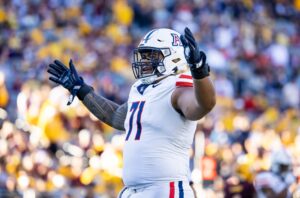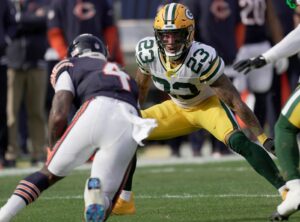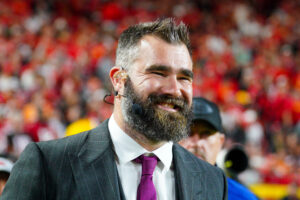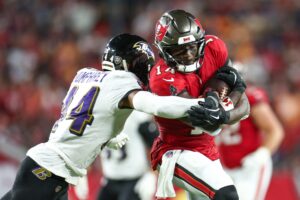Following the Philadelphia Eagles week two loss against the Kansas City Chiefs, there was plenty to talk about in what could have been. Whether it be the dropped passes on big plays by Torrey Smith that could have changed the game, the struggles of starting left guard Isaac Seumalo, who factored into allowing at least four of the six sacks allowed, or the momentum that was killed at the end of the first half when new kicker Jake Elliott missed a game-tying field goal after a timeout was called to freeze him. Fortunately for those three players, the focus after the game was solely on the nonexistent running game, and more importantly, the lack of attempts at even running the ball. The outcry for a more balanced Eagles run-pass ratio is a broken record that will likely continue to fall on deaf ears, depending on the game, for a multitude of reasons.
The Philadelphia Eagles Run-Pass Ratio Broken Record
A Variation of a Familiar West Coast Offense
For years, Eagles’ fans had begged and pleaded with anyone who would listen for their head coach Andy Reid to run the ball more. In Reid’s West Coast offense, he spent more time getting the running back the ball in quick pass situations and use them as a decoy to open passing lanes for their wide receivers than worrying about balancing out the number of carries to the pass plays. The thought process was that if they had a comfortable enough lead, they could focus on running the ball to milk the clock and that should balance out the ratio.
As a disciple of Reid, current Eagles coach Doug Pederson runs the offense in a very similar fashion. The offense is based on a pass-first mentality, utilizing mismatches with their running backs against slower linebackers and tight ends against smaller cornerbacks, of quick passes designed to control the ball as an alternative to the running game. These short passes are meant to have the same effect on a defense as running the ball since they won’t be able to just sit back and wait for a pass downfield. Although the mindset of this offense is normally the same, the tempo and situation of the game can absolutely have an influence on the effectiveness.
Situational Football and Game Flow
Speaking of influence on the team’s offensive play-calling, Pederson had blamed situational football and game flow for reasons that the team had not run the ball more in the game against the Chiefs. This response to the lack of rushing attempts had gained a collective eye roll from most that had heard it but it doesn’t make the statement any less true. The fact of the matter is, no matter how close the game felt, the Eagles trailed for a majority of the contest which led to the Eagles playing catch-up and feeling the need to throw the ball more.
Ever since Pederson was hired, the Eagles have been pretty close to a 65/35 split on passes versus run plays when losing, not including the final two minutes of the half or the game, as those numbers lean toward mostly passes. The Eagles ended up only running the ball 13 times by design, with only eight of those coming while behind in the game, as opposed to 37 pass attempts. The number of pass attempts is actually higher due to the fact that they threw 11 passes in the final two minutes of the game in an attempt to come back from their 14 point deficit.
With the numbers of 26 passes compared to eight non-quarterback rushes, that leaves their run-pass ratio to be about 75/25, which considering the high power of the Chiefs offense and the need to keep up with them, the ratio should not really be that surprising. Especially considering Pederson is a former quarterback and will always be partial to putting the ball in the quarterback’s hands to make a play when one is needed.
Three Former Quarterbacks Running the Offense
In addition to Pederson, offensive coordinator Frank Reich and quarterbacks coach John DeFilippo are former quarterbacks as well. A dream scenario for a team looking to groom a young promising quarterback, the experience surrounding Carson Wentz is overwhelming and should contribute a lot to his development. The negative of having so many former quarterbacks making decisions is that they are all partial to that position. When push comes to shove, they would all rather throw the ball in key situations due to the mentality of wanting the ball in their hands when the game is on the line.
Unfortunately, with those three likely echoing each other’s sentiments on what may be more important throughout the course of a game, running backs coach Duce Staley is the odd man out. Staley, a former Eagles running back, likely has some contention to the number of passes taking away carries from his guys but he is seemingly outnumbered in this situation. He has done his part in talking up each and every one of the running backs, including the recently injured rookie Donnel Pumphrey, and there is no doubt, knowing the player that he was, that he wants his guys to pound the ball and get their fair share of the opportunities. Even though he may be trying to do right by his players, the truth is that the position for the Eagles is just not as talented as he claims.
Lack of Running Back Talent Never Addressed
The overall lack of talent at the running back position could be the biggest factor for the increasing differential in pass attempts to runs. Arguably the best of the bunch is Darren Sproles, a 33-year-old undersized running back who was not even an every down back in his prime and definitely will not be now at his age. LeGarrette Blount, the biggest addition in free agency at this position for the Eagles, was still available in the middle of May for a reason. Not only is he aging and losing the little bit of a step he once had, he is a one-dimensional volume runner that does not really fit in today’s NFL with his lack of ability to catch out of the backfield, which is especially needed in the West Coast Offense.
Wendell Smallwood and Corey Clement are both guys who may find themselves not on the roster next year if they address the position correctly, let alone get meaningful playing time, barring injury, on this year’s team. Clement may be the most interesting of the bunch, as an undrafted rookie, but even he might not have made the team this year had they drafted a running back a bit earlier than they did. Smallwood’s days with the team seem to be numbered as well as he has been given opportunities, last year and this year, to show this team something to get excited over in a game and he has not produced.
Lastly, in the 2017 NFL draft, which was known as a very strong running back draft class, Howie Roseman was unsuccessful on drafting one of the top running backs. Focusing on other needs early in the draft, they needed to trade up in order to select Pumphrey, strictly out of positional need. Roseman’s hand was forced since he didn’t go up to grab one of the top guys earlier in the draft and they are hopeful that he could eventually pan out. After tearing a hamstring in practice following their week one matchup against the Washington Redskins, it likely won’t be until next season to see if Pumphrey can contribute to this team in any way, but that does not truly help them for this season.






